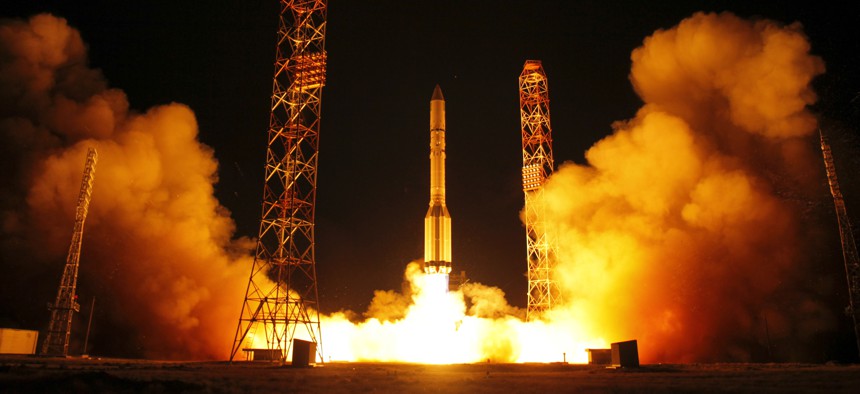
The Proton-M rocket booster blasts off at the Russian leased Baikonur cosmodrome, Kazakhstan, Tuesday, Sept. 12, 2017. The Russian rocket carries Amazonas 5, a Ku- and Ka-band communications satellite for broadband and telecommunications services. AP Photo/Dmitri Lovetsky
The US Is Worried That a Russian Satellite Is Really a Weapon
It could be practicing to fix other spacecraft—or blow them up.
When the satellite Cosmos 2519 was launched into space by Russia last year, the world did not know why.
Now, a US diplomat warned a global arms control conference in Geneva on Aug. 14 that “we are concerned with what appears to be very abnormal behavior by a declared ‘space apparatus inspector.’ We don’t know for certain what it is, and there is no way to verify it.”
A Russian diplomat called the comment “slanderous.”
The official statement from Yleem Poblete, the top US diplomat on arms control issues, suggests American intelligence agencies have reason to believe the satellite may be surveilling US space assets—or practicing to attack them in the future.
After launch, Cosmos 2519 deployed two smaller satellites, and maneuvered to rendezvous with them. Because bringing propellant to space is difficult, most satellites are designed to fly to a designated orbit and then make small adjustments to their position. A satellite that can travel between orbits to check in on other satellites is relatively unusual.
Such a vehicle could be used for many purposes: To perform maintenance on or re-fuel older satellites, extending their lives, or to clean up space debris, even sending old satellites to storage orbits or to burn up in the atmosphere. It could also be used to spy on other satellites and attack them with lasers, robotic manipulators or simply by crashing into them.
The US military is certainly tracking the Russian satellite’s position using ground-based radar, but the ability to ascertain what it is doing is limited. Powerful cameras at ground bases or on spy satellites can zoom in on passing spacecraft only if its orbit aligns with their field of view.
China and Russia have been performing more tests of “dual use” space hardware that could be innocuous or a weapon. Vladimir Putin announced a package of new weapons programs earlier this year, including an anti-satellite laser. That escalation is one reason why the US is considering the creation of a dedicated military force for space.
The US, of course, has its own military capabilities in space. It tested an anti-satellite missile in 2008, and regularly operates the X-37B spacecraft, a miniature space shuttle that can also maneuver in space and whose purpose is the subject of much speculation.
Most valuable space assets—constellations of huge navigation, communications, surveillance and missile-detection satellites—are protected largely because they are so far away from Earth and orbiting quickly. As potential adversaries demonstrate the ability to reach out and touch these, they are far more vulnerable than they appeared just a few years ago.




